The ceiling is the lower part of the protective structure at the boundary with the upper floor. Surface finishing is done directly on the floor slab or they put a false ceiling with their own hands in order to lay a layer of insulation from cold, sound, moisture. The shape of the ceiling can be flat, multi-level or domed - it all depends on the interior solution.
Design features of ceilings
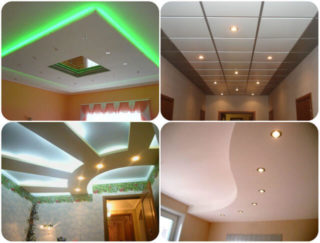
Suspended structures are modular and solid. The first category includes tile, cassette and other small-sized systems. Plasterboard and stretch ceilings with a single finishing layer are referred to the second group.
Single-level ceilings are plastered, plastered, pasted over with finishing elements on a reinforced concrete base. Multi-level are a frame version in which they hide wiring, ventilation, and other communications, such structures take the height of the room.
The protruding level is placed over the entire area, made in the form of an island with illumination, or placed around the perimeter of the room. The lateral structure of the lowered layer is open and closed. In the first version, tape lighting is placed.
Finishing methods
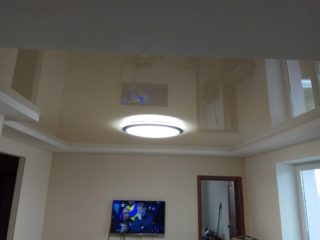
Wet finishes include plastering, plastering and painting - these methods are among the budget options for finishing the ceiling in a private house. A supporting frame is not built for them, but the work takes a long time because of the waiting for the layers to dry.
Stretch ceilings are gaining more and more popularity, since the work takes several hours. The result is a smooth and beautiful high performance finish. Films are combined with plasterboard systems, plastic, and produced with artistic drawings.
Plasterboard ceilings take time to install and surface. They are plastered, painted, wallpaper is glued over the area. With the help of liquid types of wallpaper, they create a textured surface with an original combination.
Whitewashing and painting
For such a finish, the ceiling area is leveled with putty and primed with deeply penetrating agents.
Whitewashing happens:
- chalk;
- calcareous.
The first composition includes sifted chalk, blue, some wood glue and water. For lime whitewashing, take slaked lime, dyes, table salt and alum. Before lime whitewashing, moisten the surface, work with brushes or sprayers (spray guns).
For painting take:
- latex acrylic compounds;
- silicate;
- silicone.
The first type is the most popular, it is enough to apply one layer of high-quality composition. Silicate paints are used for mineral plasters or on old lime coatings.
Silicone types combine the best characteristics of acrylic and silicate structures. Belongs to the category of breathable coatings, although they are impervious to water.
Wallpaper
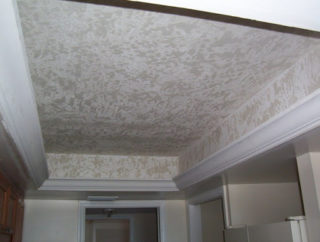
Wallpaper on a paper or non-woven base is glued to the ceiling. The second type of cladding fits snugly to the base, does not blow up with bubbles when wet. Non-woven fabric is not impregnated with glue, the product is applied only to the ceiling surface. Paper wallpaper regulates the humidity in the apartment by absorbing a certain amount of household steam. Under them, specialists glue a non-woven base on which paper strips are installed.
The wallpaper is combined with other types of coating, for example, putty and paint. To determine the boundaries, foam moldings are placed on the ceiling. A decorative carpet is laid out from the wallpaper on the ceiling, several types of material are used. There are vinyl wallpapers that can be painted with any formulation.
Tile
Styrofoam parts of various shapes are placed on the ceiling in the room. Most often there are squares with a side of 50 cm, but they are in the form of honeycombs, rectangles, semicircular. They can be used to inexpensively decorate the ceiling in the country, in the apartment such material is used in the bathroom, kitchen, corridor.
Types of tiles:
- pressed - made up to 7 mm thick;
- injection - produced 7 - 14 mm are made by sintering PVC granules at a high temperature;
- extruded - pass through the mold, then covered with a decorative film or painted.
There are elements with imitation of various materials, for example, stone, lining, wooden texture. The details of the coating are lightweight, so they are placed on any surfaces. The tile does not react to temperature changes, dampness, but is afraid of overheating (from the chandelier). Installation can be done by yourself.
Drywall
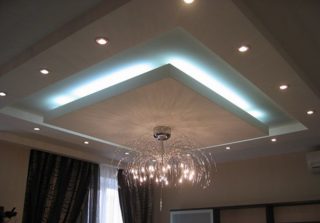
Gypsum panels with a double-sided construction cardboard coating are classified as versatile materials that are used in different conditions. Complex multi-level ceiling structures are made of them. The sheets are also suitable for those who want to make the suspended ceiling even and smooth, without protrusions.
For the ceiling, moisture-resistant panels are used, their size is 2.5 m in length, 1.2 m in width, and a thickness of 9.5 mm. The sheets are colored green and marked with blue letters. They differ from ordinary material in that modifiers are added to the gypsum mass during production to reduce saturation with water, and the cardboard itself is treated with a moisture repellent.
You can assemble the frame without leveling the ceiling surface. Installation takes place according to the instructions, which are studied before work.
Rack
The panels are installed in the bathroom, kitchen or corridor. The plastic slats are bent so that, when joined with adjacent elements, they form a depression along the entire length of the strip. The surface of the recess is treated with a silvery or golden coating, resulting in a beautiful combination of wide white and narrow mirrored stripes.
Installation of plastic is done on a frame made of strips or galvanized profiles. The material is not destroyed by water, dampness, household steam. The layer protects against drafts and dampens sound due to internal cells. Plastic is inexpensive and has various thicknesses. For edging, start stripes and an angle profile are preliminarily placed. The coating is easy to clean and lasts a long time on the ceiling.
Cassette

Cassette ceilings made of aluminum and steel are used. The standard dimensions of the element are 600 x 600 mm, one piece weighs about 3.5 kg. Luminaires for cassette ceilings are also made according to standard sizes, so they fit into the overall frame and do not interfere with the periodicity of cassette placement. Filling elements are produced in gold, chrome, white, perforated to order.
The frame is made:
- drowned;
- standard;
- without visible guides.
The cassettes are easy to remove, so there is always access to the ventilation manifolds and wiring. The reflective surface of the elements increases the illumination of the room. Filling the frame squares can be mounted and removed multiple times.
Suspension
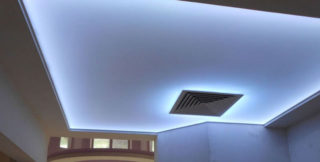
The category of suspended structures includes all structures that are performed on a supporting frame. The base is made of a wooden lath, which is treated with antiseptics or linseed oil heated to 60 ° C. Use a rail with a section of 40 x 20 or 50 x 20 mm. It is fastened to the ceiling with ES brackets, which are used in g / cardboard constructions.
For the frame from the profile, galvanized profiles are installed:
- bearing girders CD-60;
- strap around the perimeter of the room UD-25.
The brackets are fixed to the ceiling with a plastic dowel with a self-tapping screw, and the metal parts are connected using flea screws. The g / cardboard cover is fixed with self-tapping screws for metal 40 mm in size with fine thread, plastic or siding is fixed with "flea beetles" or shot with staples from a stapler.
Tension
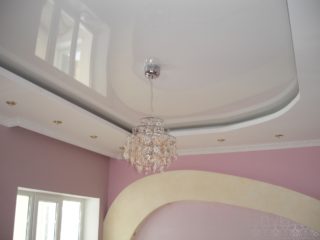
It is an elastic stretched canvas; for installation, a profile is placed around the perimeter of the room, the material of which is durable plastic or aluminum.
For tensioning systems, the material is used:
- polyvinyl chloride film;
- fabric (polyester) treated with polyurethane.
The canvas has a width of 1.3 to 3 m, therefore, indoors, such surfaces are stretched without a connecting seam. For PVC material, a seam is allowed on wider areas, and fabrics are made without joining.
The width on the roll is not a final value, because when heated, the fabric receives an additional 10 - 20 cm. The surface of the material is glossy, satin or matte. Produce types with an applied pattern or pattern.
Plaster
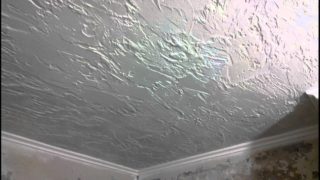
On the ceiling, plaster is applied after gluing a mesh of plastic or metal, especially in those places where the layer exceeds 1.5 cm.For the top coating, alabaster or chalk is added to the solution of sand and cement so that the solution adheres to the surface and is convenient to throw.
Modern plaster solutions are produced in the form of a dry powder, which is sold in bags of 25 - 30 kg, which is mixed with water before use. These mixtures contain polymer additives that increase the tackiness of the solution and its strength. Compositions for interior work are produced on the basis of alabaster.
If the surface is whitewashed, there is wallpaper or old paint on it, the surface is cleaned to the floor slab, only then they proceed to plastering.
Glass
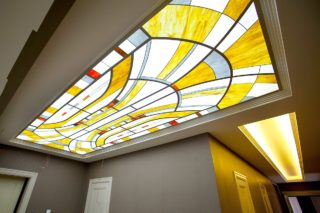
The idea of sheathing the ceiling with glass squares is a kind of cassette ceiling device. The coating does not react to heating, temperature changes, and is hypoallergenic. It can be built with luminaires containing incandescent bulbs and LED elements.
The glossy surface visually increases the height of the room, increases the degree of illumination. Glass does not burn, but in case of fire it can crack and create dangerous fragments. In modern tiles, fibrous mass is used, which in this case only cracks, but does not scatter.
Such ceilings protect from drafts and cold due to the air gap, but the glass conducts noise well, so the surface has no sound insulation effect.
Rough finish
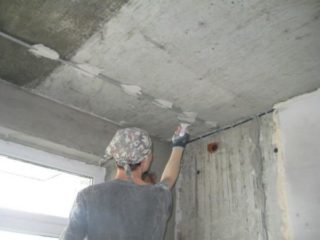
This type of area processing is used at the first stage of finishing, before the start of the main work.
Professional training includes:
- cleaning the ceiling from old and peeling coatings with a spatula or grinder;
- leveling the plane with a solution using a grid or beating off projections;
- jointing and repair of cracks;
- ceiling primer.
For a hinged structure, a rough finish consists in marking lines for the further installation of frame elements. They will also level the height of the future structure. Lowering the ceiling is taken at the lowest point of the surface.
DIY installation instructions
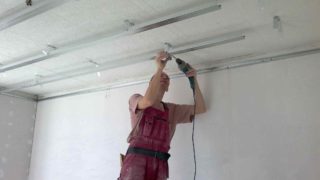
For quality work, you need to follow the instructions and work sequence. Marking and determining the general picture of the location of the elements is important, therefore, use a laser level or use a regular construction level.
The order of work on the installation of the ceiling:
- fixing the UD profile along the perimeter of the walls of the room at the selected height;
- installation of hangers-ES brackets on the ceiling in width after 40 cm, and along the length in increments of 60 cm;
- installation of load-bearing girders from the SD profile, the ends are brought into the UD strip, and the body is attached to the suspensions;
- fixing g / cardboard panels to profiles;
- putty of joints (with a grid) and holes from self-tapping screws;
- finishing according to the selected type.
A perforator, a screwdriver, knives on g / cardboard are used. They use cords, a tape measure, a square in their work. Trowels and a primer brush are required to seal the joints.
If the room is small and the ceiling area is even, the sheets are attached to the ceiling with glue. For this, beacons are placed from strips and pieces of g / cardboard, to which the material will be mounted. The glue can be replaced with foam. If there is a problem area, additionally fix it with a dowel to the ceiling.
Ceiling decoration in non-residential premises
In industrial and public premises, ventilation ducts must be provided in the structure, so the plane of the ceiling is lowered more. The roofs of such buildings are not always insulated, therefore, the suspended ceiling technology includes the installation of an insulating layer against the cold.
Ceiling decoration in office premises is subject to the general design and interior of the entire building. Ceiling coverings must be strong and durable so that work does not stop for temporary repairs. For office rooms, cassette, rack options are used, drywall is made with painting. Decorative types of plaster with a corrugated surface are used.








